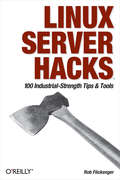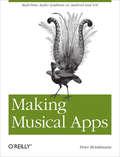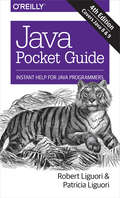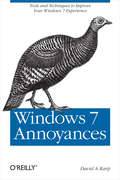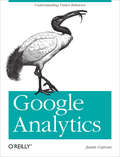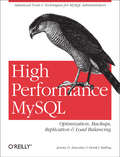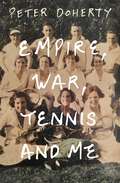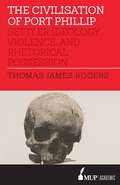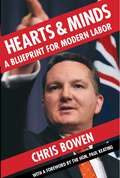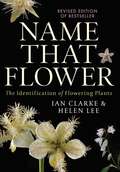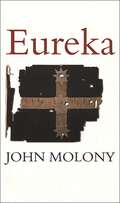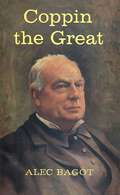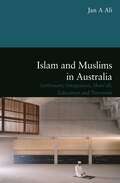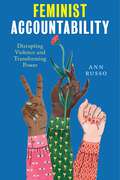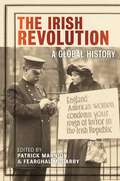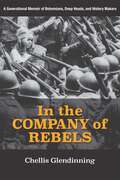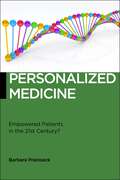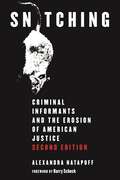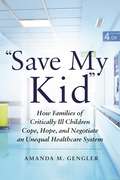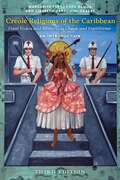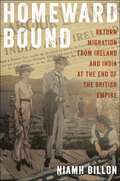- Table View
- List View
Linux Server Hacks: 100 Industrial-Strength Tips and Tools
by Rob FlickengerA competent system administrator knows that a Linux server is a high performance system for routing large amounts of information through a network connection. Setting up and maintaining a Linux server requires understanding not only the hardware, but the ins and outs of the Linux operating system along with its supporting cast of utilities as well as layers of applications software. There's basic documentation online but there's a lot beyond the basics you have to know, and this only comes from people with hands-on, real-world experience. This kind of "know how" is what we sought to capture in Linux Server Hacks.Linux Server Hacks is a collection of 100 industrial-strength hacks, providing tips and tools that solve practical problems for Linux system administrators. Every hack can be read in just a few minutes but will save hours of searching for the right answer. Some of the hacks are subtle, many of them are non-obvious, and all of them demonstrate the power and flexibility of a Linux system. You'll find hacks devoted to tuning the Linux kernel to make your system run more efficiently, as well as using CVS or RCS to track the revision to system files. You'll learn alternative ways to do backups, how to use system monitoring tools to track system performance and a variety of secure networking solutions. Linux Server Hacks also helps you manage large-scale Web installations running Apache, MySQL, and other open source tools that are typically part of a Linux system.O'Reilly's new Hacks Series proudly reclaims the term "hacking" for the good guys. Hackers use their ingenuity to solve interesting problems. Rob Flickenger is an experienced system administrator, having managed the systems for O'Reilly Network for several years. (He's also into community wireless networking and he's written a book on that subject for O'Reilly.) Rob has also collected the best ideas and tools from a number of other highly skilled contributors.Written for users who already understand the basics, Linux Server Hacks is built upon the expertise of people who really know what they're doing.
Making Musical Apps: Real-time audio synthesis on Android and iOS
by Peter BrinkmannWant to turn your mobile device into a musical instrument? Or equip your game with interactive audio, rather than canned samples? You can do it with Pure Data (Pd), an open source visual programming environment that lets you manipulate digital audio in real time. This concise book shows you how to use Pd—with help from the libpd library—as an easily embeddable and widely portable sound engine.Whether you’re an audio developer looking to create musical apps with sophisticated audio capabilities, or an application developer ready to enhance mobile games with real-time procedural audio, Making Musical Apps introduces you to Pd and libpd, and provides hands-on instructions for creating musical apps for Android and iOS.Get a crash course in Pd, and discover how to generate and control soundsLearn how to create and deploy algorithmic compositions that react to a user’s activity and environmentUse Java or Objective-C to integrate Pd and libpd into mobile appsLearn the steps necessary to build libpd-based apps for Android and iOS
Java Pocket Guide: Instant Help for Java Programmers
by Patricia Liguori Robert LiguoriAny time you need quick answers for developing or debugging Java programs, this pocket guide is the ideal reference to standard features of the Java programming language and its platform. Youâ??ll find helpful programming examples, tables, figures, and lists fastâ??including Java 9 features such as modular source code and the new JShell interactive command-line REPL. Itâ??s a handy companion, whether youâ??re in the office, in the lab, or on the road.This book also provides material to help you prepare for the Oracle Certified Associate Java Programmer exam.Quickly find Java language details, such as naming conventions, types, statements and blocks, and object-oriented programmingGet details on the Java SE platform, including development basics, memory management, concurrency, and genericsUse new features in Java 9, including modular source code and JShellBrowse through information on basic input/output, NIO 2.0, the Java collections framework, and the Java Scripting APIGet supplemental references to fluent APIs, third-party tools, and basics of the Unified Modeling Language (UML)
Windows 7 Annoyances: Tips, Secrets, and Solutions
by David A. KarpWindows 7 may be faster and more stable than Vista, but it's a far cry from problem-free. David A. Karp comes to the rescue with the latest in his popular Windows Annoyances series. This thorough guide gives you the tools you need to fix the troublesome parts of this operating system, plus the solutions, hacks, and timesaving tips to make the most of your PC.Streamline Windows Explorer, improve the Search tool, eliminate the Green Ribbon of Death, and tame User Account Control promptsExplore powerful Registry tips and tools, and use them to customize every aspect of Windows and solve its shortcomingsSqueeze more performance from your hardware with solutions for your hard disk, laptop battery, CPU, printers, and moreStop crashes, deal with stubborn hardware and drivers, fix video playback issues, and troubleshoot Windows when it won't startProtect your stuff with permissions, encryption, and shadow copiesSecure and speed up your wireless network, fix networking woes, make Bluetooth functional, and improve your Web experienceGet nearly all of the goodies in 7 Ultimate, no matter which edition you have"Blunt, honest, and awesome."--Aaron Junod, Manager, Integration Systems at Evolution Benefits"This could be the best [money] you've ever spent."--Jon Jacobi, PC World"To use Windows is to be annoyed -- and this book is the best way to solve any annoyance you come across. It's the most comprehensive and entertaining guide you can get for turning Windows into an operating system that's a pleasure to use."--Preston Gralla, author of Windows Vista in a Nutshell, and Computerworld contributing editor
Building Maintainable Software, C# Edition: Ten Guidelines for Future-Proof Code
by Rob van der Leek Gijs Wijnholds Joost Visser Sylvan Rigal Pascal Van EckHave you ever felt frustrated working with someone else’s code? Difficult-to-maintain source code is a big problem in software development today, leading to costly delays and defects. Be part of the solution. With this practical book, you’ll learn 10 easy-to-follow guidelines for delivering C# software that’s easy to maintain and adapt. These guidelines have been derived from analyzing hundreds of real-world systems.Written by consultants from the Software Improvement Group (SIG), this book provides clear and concise explanations, with advice for turning the guidelines into practice. Examples for this edition are written in C#, while our companion Java book provides clear examples in that language.Write short units of code: limit the length of methods and constructorsWrite simple units of code: limit the number of branch points per methodWrite code once, rather than risk copying buggy codeKeep unit interfaces small by extracting parameters into objectsSeparate concerns to avoid building large classesCouple architecture components looselyBalance the number and size of top-level components in your codeKeep your codebase as small as possibleAutomate tests for your codebaseWrite clean code, avoiding "code smells" that indicate deeper problems
Google Analytics: Understanding Visitor Behavior
by Justin CutroniDo you know what people do when they visit your website or web app? Or how much the site contributes to your bottom line? Google Analytics keeps track and makes it easy for you to learn precisely what's happening. This hands-on guide shows you how to get the most out of this free and powerful tool -- whether you're new to Google Analytics or have been using it for years.Google Analytics shows you how to track different market segments and analyze conversion rates, and reveals advanced techniques such as marketing-campaign tracking, a valuable feature that most people overlook. And this practical book not only provides complete code samples for web developers, it also explains the concepts behind the code to marketers, managers, and others on your team.Discover exactly how the Google Analytics system worksLearn how to configure the system to measure data most relevant to your business goalsTrack online marketing activities, including cost-per-click ads, email, and internal campaignsTrack events -- rather than page views -- on sites with features such as maps, embedded video, and widgetsConfigure Google Analytics to track enterprise data, including multiple domainsUse advanced techniques such as custom variables and CRM integration
High Performance MySQL: Optimization, Backups, Replication, Load Balancing & More
by Derek J. Balling Jeremy D. ZawodnyAs users come to depend on MySQL, they find that they have to deal with issues of reliability, scalability, and performance--issues that are not well documented but are critical to a smoothly functioning site. This book is an insider's guide to these little understood topics.Author Jeremy Zawodny has managed large numbers of MySQL servers for mission-critical work at Yahoo!, maintained years of contacts with the MySQL AB team, and presents regularly at conferences. Jeremy and Derek have spent months experimenting, interviewing major users of MySQL, talking to MySQL AB, benchmarking, and writing some of their own tools in order to produce the information in this book.In High Performance MySQL you will learn about MySQL indexing and optimization in depth so you can make better use of these key features. You will learn practical replication, backup, and load-balancing strategies with information that goes beyond available tools to discuss their effects in real-life environments. And you'll learn the supporting techniques you need to carry out these tasks, including advanced configuration, benchmarking, and investigating logs.Topics include:A review of configuration and setup optionsStorage engines and table typesBenchmarkingIndexesQuery OptimizationApplication DesignServer PerformanceReplicationLoad-balancingBackup and RecoverySecurity
Oracle SQL Tuning Pocket Reference: Write Efficient SQL
by Mark GurryOne of the most important challenges faced by Oracle database administrators and Oracle developers is the need to tune SQL statements so that they execute efficiently. Poorly tuned SQL statements are one of the leading causes of substandard database performance and poor response time. SQL statements that perform poorly result in frustration for users, and can even prevent a company from serving its customers in a timely manner.In this book, Mark Gurry shares his in-depth knowledge of Oracle's SQL statement optimizers. Mark's knowledge is the result of many hard-fought tuning battles during his many years of providing Oracle tuning services to clients. Mark provides insights into the workings of the rule-based optimizer that go well beyond what the rules tell you. Mark also provides solutions to many common problems that occur with both the rule-based and cost-based optimizers. In addition to the specific problem/solution scenarios for the optimizers, Mark provides a number of handy SQL tuning tips. He discusses the various optimizer hints, telling you when they can be used to good effect. Finally, Mark discusses the use of the DBMS_STATS package to manage database statistics, and the use of outlines to specify execution plans for SQL statements in third-party applications that you can't otherwise modify.
Baby Lost: A Story of Grief and Hope
by Hannah RobertWhat happens when a death occurs within your body, but you survive? Two days after Christmas, law lecturer Hannah Robert, eight months pregnant, was driving her partner and stepkids home from a picnic when their car was crushed by a four-wheel-drive. Hannah's baby didn't survive.When Hannah told her story in court, the judge wept. In her struggle to make sense of the personal and legal aftermath, Hannah had to find out what it means to mother a dead child and to renegotiate her own relationship with hope. Her powerful story is written with clarity and beauty, shining light on an unimaginably dark event and is, unexpectedly, tempered with life and promise.
Empire, War, Tennis and Me
by Peter DohertyFor those who look, and think deeply, new connections emerge. Peter Doherty, one of the world's foremost authorities on immunology, recipient of the Nobel Prize for medicine, and an active and respected commentator on public health, reflects in this book on empire, war and tennis. Doherty identifies the origins of modern tennis within its imperial context, relating seemingly unlikely connections between the sport, its players and national militaries. He traces the fate of tennis-and its players-as a nascent force for internationalism and cultural tolerance within the context of World War II. And he personalises this account through an unsentimental but revealing depiction of his tennis-loving Queenslander uncles, at war and in captivity in the Pacific. As Doherty shows, tennis and war have threaded their way through the lives of many people since the nineteenth century, in a way intriguingly unique to this sport. This is part of Peter's story. And, as we come to realise, it is also part of the story of our world.
Civilisation of Port Phillip: Settler ideology, violence, and rhetorical possession
by Thomas James RogersPort Phillip's free settlers often said that they were civilising a wilderness. The truth was that the occupied country already had people, laws, politics, and economies. What did 'civilisation' mean to the free settlers? And what was the relationship between civilising and violence? The Civilisation of Port Phillip tracks the violent history of the first years of British settlement in the Port Phillip District, now the state of Victoria. It illuminates the underlying free-settler rhetoric that advocated and abetted violence on the frontier. For the first time, we hear the settlers tell us in their own words what the civilisation of Port Phillip really involved. Frontier violence in Port Phillip involved Aboriginal peoples, convicts, free settlers and colonial officials. This history shows how the lives of these different people interconnected in early Port Phillip, in unlikely friendships, dire misunderstandings, and fatal clashes. It paints a vivid picture of the period drawn from archival records, a thorough re-reading of older histories, and new ideas in the scholarship of violence. As well as sheep and firearms, free settlers brought Enlightenment ideas about civilisation to Port Phillip. When these European ideas were coupled with Australian frontier experience, they manifested in an exterminatory attitude towards people deemed undesirable in the coming colony. The Civilisation of Port Phillip shows how free-settler rhetoric, law, and systems of classification reinforced and sought to justify the violence of the frontier.
Hearts & Minds: A Blueprint for Modern Labor
by Chris BowenIn Hearts & Minds: A Blueprint for Modern Labor, Treasurer Chris Bowen writes a passionate clarion call to Labor's heartland, making the powerful argument that the Labor project is far from complete and it is time for a radical program of renewal and reform for the party. Hearts & Minds is a manifesto to secure the ALP's position as the dominant force in Australian politics. It advocates for governing alone or not at all, opening up the election of the parliamentary leader to party members as well as caucus, and support for the carbon tax. Bowen argues for instituting primaries wherever there is no sitting ALP member and allowing a broader range of groups to affiliate with the party. Bowen writes that the measures he suggests will see the ALP become a bigger, stronger and more inclusive party, delivering economic growth and improved opportunity, reflecting the aspirations of all Australians. Hearts & Minds: A Blueprint for Modern Labor offers Bowen's insights for the party he believes can create a better and fairer nation.
Name that Flower: The Identification of Flowering Plants: 3rd Edition
by Helen Lee Ian ClarkeName That Flower is a valued source of clear and concise information on identifying flowering plants from around the world, both cultivated and in the wild. This edition is updated to align with current systems of plant classification that incorporate advances in molecular DNA analysis. It includes more than 130 detailed line drawings, 64 colour pages and information on 46 plant families. The illustrations depict a selection of widely distributed gardens plants and weeds, and species native in eastern and southeastern Australia. Easily navigated, the book facilitates the successful use of standard identification manuals and online resources available in most parts of the world and introduces the reader to the arrangement of flowers on plants, reproduction, plant structure and function, and the way species are grouped and named. Methods for dissecting flowers and observing their structure for identification purposes are clearly described. This bestseller is used extensively as a teaching text in numerous courses concerned with the natural world, such as agriculture, horticulture, botany, environmental management and landscape design, as well as botanical art. It is an essential reference for serious gardeners and keen botanists, professional and amateur.
Eureka
by John MolonyBefore dawn on 3 December 1854, colonial troopers at Ballarat attacked a group of gold miners who had thrown up a stockade in defiance and defence. Some diggers had guns, but many were unarmed; some twenty of them were killed, along with four troopers. In the decades that followed, the truth of what happened that morning became obscured by partisans on both sides. For many years the Eureka Stockade was regarded as a shameful event and almost forgotten; more recently, it has been celebrated as a righteous stand against injustice. John Molony's Eureka vividly recreates the story of Eureka and unravels the myths that have come to surround it. This new edition of Molony's classic work, now beautifully illustrated with historic Eureka images, will be welcomed by everyone with an interest in the history of Australian democracy.
Coppin the Great: Father of the Australian Theatre
by Alec BagotGeorge Seith Coppin (1819-1906), known as 'father of the Australian Theatre', a 'low comedian', was also impresario, adventurer, politician and philanthropist. This biography is based mainly on material made available by the late Miss Lucy Coppin: her father's books, journals, biographical notes, press cut-tings, playbills, and Coppin's personal letters. From an early age he acted with his parents in a troupe of strolling players in England and the colour-and uncertainties-of this life are vividly described. At 16 he chose in-dependence and appearances in provincial England, London, and Ireland followed. In 1842, accompanied by an American actress, he migrated to Australia where, in tours of the separate colonies, George's acumen gave them starring roles and excellent receipts. As well as acting and managing, Coppin pro-moted such ventures as a zoo, roller skating, hot sea-water baths and a railway line. He was a devoted husband and parent and his philanthropic activities were legion. Twice elected to the Victorian Legislative Council, in 1858 and 1889, Coppin was also a member of the Legislative Assembly for nine years 1874 to 1889, with a break 1877-1883. He built six theatres, including one pre-fabricated in England. He made three for-tunes and lost two, restoring them through stage tours. He toured the Victorian gold-fields and New Zealand and, later, with Charles and Ellen Kean, America. This visit coincided with a presidential election and the assassination of President Lincoln.
Islam and Muslims in Australia: Settlement, Integration, Shariah, Education and Terrorism
by Jan A AliIslam has long been a part of the multicultural landscape of major urban centres in Australia and encompasses a great diversity of theological, jurisprudential and cultural practices. Despite this, in popular discourse, media presentations, and political debates Muslims are represented as a homogeneous group. This timely book examines the growing presence of Islam and Muslims in Australia and how it is transforming, and transformed by, social, cultural and religious spaces. Employing critical analysis and macrosociology, Islam and Muslims in Australia provides valuable insights into this growth and development and illuminates how socio-cultural, economic, and political processes maintain and manage the ways Australian Muslims build their religious lives and identities and engage in the wider world, while facing the inevitable effects of modernity. This book argues that Islam in different parts of the world as well as in Australia is more than just a religion, a cultural system or a social structure, but is a complex composite of diverse institutional processes and functions, social routines and norms, and sacred rituals and practices responsible for shaping the lives of Muslims. This volume focuses on five broad areas of sociological analysis namely Muslim settlement, Muslim integration, shari'ah, Muslim education, and global terrorism.
Feminist Accountability: Disrupting Violence and Transforming Power
by Ann RussoExplores accountability as a framework for building movements to transform systemic oppression and violence What does it take to build communities to stand up to injustice and create social change? How do we work together to transform, without reproducing, systems of violence and oppression?In an age when feminism has become increasingly mainstream, noted feminist scholar and activist Ann Russo asks feminists to consider the ways that our own behavior might contribute to the interlocking systems of oppression that we aim to dismantle. Feminist Accountability offers an intersectional analysis of three main areas of feminism in practice: anti-racist work, community accountability and transformative justice, and US-based work in and about violence in the global south. Russo explores accountability as a set of frameworks and practices for community- and movement-building against oppression and violence. Rather than evading the ways that we are implicated, complicit, or actively engaged in harm, Russo shows us how we might cultivate accountability so that we can contribute to the feminist work of transforming oppression and violence. Among many others, Russo brings up the example of the most prominent and funded feminist and LGBT antiviolence organizations, which have become mainstream in social service, advocacy, and policy reform projects. This means they often approach violence through a social service and criminal legal lens that understands violence as an individual and interpersonal issue, rather than a social and political one. As a result, they ally with, rather than significantly challenge, the state institutions, policies, and systems that underlie and contribute to endemic violence. Grounded in theories, analyses, and politics developed by feminists of color and transnational feminists of the global south, with her own thirty plus years of participation in community building, organizing, and activism, Russo provides insider expertise and critical reflection on leveraging frameworks of accountability to upend inequitable divides and the culture that supports them.
The Irish Revolution: A Global History (The Glucksman Irish Diaspora Series #3)
by Patrick Mannion Fearghal McGarryHow the Irish Revolution was shaped by international actors and events The Irish War of Independence is often understood as the culmination of centuries of political unrest between Ireland and the English. However, the conflict also has a vitally important yet vastly understudied international dimension. The Irish Revolution: A Global History reassesses the conflict as an inherently transnational event, examining how circumstances and individuals abroad shaped the course Ireland’s struggle for independence.Bringing together leading international scholars of modern Ireland, its diaspora, and the British Empire, this volume discusses the Irish revolution in a truly global sense. The text situates the conflict in the wider context of the international flourishing of anti-colonial movements following World War I. Despite the differences between these movements, their proponents communicated extensively with each other, learning from and engaging with other revolutionaries in anti-imperial metropoles such as Paris, London, and New York. The contributors to this volume argue that Irish nationalists at home and abroad were intimately involved in this exchange, from mobilizing Ireland’s vast diaspora in support of Irish independence to engaging directly with radical causes elsewhere. The Irish Revolution is a vital work for all those interested in Irish history, providing a new understanding of Ireland’s place in the evolving postwar world.
In the Company of Rebels: A Generational Memoir of Bohemians, Deep Heads, and History Makers
by Chellis GlendinningMeetings with remarkable activists since the 1960s American social change movements dominated the 1960s and 1970s, an era brought about and influenced not by a handful of celebrity activists but by people who cared. These history makers together transformed the political and spiritual landscape of America and laid the foundation for many of the social movements that exist today. Through a series of 43 vignettes—tight biographical sketches of the characters and intimate memories of her personal encounters with them—the author creates a collective portrait of the rebels, artists, radicals, and thinkers who through word and action raised many of the issues of justice, the environment, feminism, and colonialism that we are now familiar with. From Berkeley to Bolivia, from New York to New Mexico, a complex, multi-layered radical history unfolds through the stories and lives of the characters. From Marty Schiffenhauer, who fought through the first rent-control law in the United States, to Ponderosa Pine, who started the All-Species Parade and never wore shoes, to Dan and Patricia Ellsberg, who released the Pentagon Papers and became life-long anti-war and antinuclear activists, the portraits bring out some of the vibrant, irreverent energy, the unswerving commitment, and the passion for life of these generations of activists. In our present moment, as many people find themselves in the streets protesting for the first time in their lives, In the Company of Rebels makes the connection to this relatively recent rebellious era.As the author comments on her own twenty-year old self, sitting at the counter of Cody’s Books in Berkeley in the early 1970s, thrilled about the times but oblivious of the work that came before: “I didn’t know anything about this courageous and colorful past. But now I know.”
Personalized Medicine: Empowered Patients in the 21st Century? (Biopolitics #7)
by Barbara PrainsackInside today's data-driven personalized medicine, and the time, effort, and information required from patients to make it a realityMedicine has been personal long before the concept of “personalized medicine” became popular. Health professionals have always taken into consideration the individual characteristics of their patients when diagnosing, and treating them. Patients have cared for themselves and for each other, contributed to medical research, and advocated for new treatments. Given this history, why has the notion of personalized medicine gained so much traction at the beginning of the new millennium? Personalized Medicine investigates the recent movement for patients’ involvement in how they are treated, diagnosed, and medicated; a movement that accompanies the increasingly popular idea that people should be proactive, well-informed participants in their own healthcare.While it is often the case that participatory practices in medicine are celebrated as instances of patient empowerment or, alternatively, are dismissed as cases of patient exploitation, Barbara Prainsack challenges these views to illustrate how personalized medicine can give rise to a technology-focused individualism, yet also present new opportunities to strengthen solidarity. Facing the future, this book reveals how medicine informed by digital, quantified, and computable information is already changing the personalization movement, providing a contemporary twist on how medical symptoms or ailments are shared and discussed in society. Bringing together empirical work and critical scholarship from medicine, public health, data governance, bioethics, and digital sociology, Personalized Medicine analyzes the challenges of personalization driven by patient work and data. This compelling volume proposes an understanding that uses novel technological practices to foreground the needs and interests of patients, instead of being ruled by them.
Snitching: Criminal Informants and the Erosion of American Justice, Second Edition
by Alexandra NatapoffReveals the secretive, inaccurate, and often violent ways that the American criminal system really worksCurtis Flowers spent twenty-three years on death row for a murder he did not commit. Atlanta police killed 92-year-old Kathryn Johnston during a misguided raid on her home. Rachel Hoffman was murdered at age twenty-three while working for Florida police. Such tragedies are consequences of snitching. Although it is nearly invisible to the public, the massive informant market shapes the American legal system in risky and sometimes shocking ways. Police rely on criminal suspects to obtain warrants, to perform surveillance, and to justify arrests. Prosecutors negotiate with defendants for information and cooperation, offering to drop charges or lighten sentences in exchange. In this book, Alexandra Natapoff provides a comprehensive analysis of this powerful and problematic practice. She shows how informant deals generate unreliable evidence, allow serious criminals to escape punishment, endanger the innocent, and exacerbate distrust between police and poor communities of color. First published over ten years ago, Snitching has become known as the “informant bible,” a leading text for advocates, attorneys, journalists, and scholars. This influential book has helped free the innocent, it has fueled reform at the state and federal level, and it is frequently featured in high-profile media coverage of snitching debacles. This updated edition contains a decade worth of new stories, new data, new legislation and legal developments, much of it generated by the book itself and by Natapoff’s own work. In clear, accessible language, the book exposes the social destruction that snitching can cause in heavily-policed Black neighborhoods, and how using criminal informants renders our entire penal process more secretive and less fair. By delving into the secretive world of criminal informants, Snitching reveals deep and often disturbing truths about the way American justice really works.
"Save My Kid": How Families of Critically Ill Children Cope, Hope, and Negotiate an Unequal Healthcare System
by Amanda M. GenglerA frank analysis of the medical and emotional inequalities that pervade the healthcare process for critically ill children Families who have a child with a life-threatening illness face a daunting road ahead of them, one that not only upends their everyday lives, but also strikes at the very heart of parenthood. In “Save My Kid,” Amanda M. Gengler traces the emotional difficulties these families navigate as they confront a fundamentally unequal healthcare system in the United States. Gengler reveals the unrecognized, everyday inequalities tangled up in the process of seeking medical care, showing how different families manage their children’s critical illnesses. She also uncovers the role that emotional goals—deeply rooted in the culture of illness and medicine—play in medical decision-making, healthcare interactions, and the end of children’s lives. A deeply compassionate read, “Save My Kid” is an inside look at inequality in healthcare among those with the most at stake.
Creole Religions of the Caribbean, Third Edition: An Introduction (Religion, Race, and Ethnicity)
by Lizabeth Paravisini-Gebert Margarite Fernández OlmosAn updated introduction to the religions developed in the Caribbean regionCreole Religions of the Caribbean offers a comprehensive introduction to the overlapping religions that have developed as a result of the creolization process. Caribbean peoples drew on the variants of Christianity brought by European colonizers, as well as on African religious and healing traditions and the remnants of Amerindian practices, to fashion new systems of belief. From Vodou, Santería, Regla de Palo, the Abakuá Secret Society, and Obeah to Quimbois and Espiritismo, the volume traces the historical–cultural origins of the major Creole religions, as well as the newer traditions such as Rastafari.This third edition updates the scholarship by featuring new critical approaches that have been brought to bear on the study of religion, such as queer studies, environmental studies, and diasporic studies. The third edition also expands the regional considerations of the diaspora to the US Latinx communities that are influenced by Creole spiritual practices, taking into account the increased significance of material culture?art, music, literature, and healing practices influenced by Creole religions.
Homeward Bound: Return Migration from Ireland and India at the End of the British Empire (The Glucksman Irish Diaspora Series)
by Niamh DillonFirsthand accounts of migrants who settled in Britain offer new insights into empire, belonging, migration, and diasporaHomeward Bound shines a light on a neglected aspect of twentieth-century migration history. It compares two groups of migrants—Southern Irish Protestants and the British in India—who “returned” to Britain from Ireland and India after independence in 1922 and 1947. By looking across national boundaries, Niamh Dillon explores both individual and collective narratives of imperial identity in the late British Empire and the prompts for return. For both groups, the success of national independence movements in the first half of the twentieth century was cataclysmic and prompted a large-scale migration to Britain. Between 1911 and 1926, the number of Protestants in the Irish Free State dropped from approximately 313,000 to 208,000, and much of the British population left India. Although these numbers are significant, these two groups have largely been ignored by historians and have not been compared before. Though instability in the new political order and lack of livelihood were determining factors in the decision to migrate, Dillon argues that Southern Irish Protestants and the British community in India “returned” to Britain after independence principally because these former elites no longer had a clearly defined role in the new post-colonial era. Return migrants chose Britain because of continuing connections with it as “home,” but often found their colonial experience was not valued in a country re-orienting itself to the post-war order. Through interviews with those who experienced these events first-hand and the recently opened files of the Irish Grants Committee at the National Archives in Britain, this book offers new insights into the history of migration and the affinity these migrants felt with Britain and with the empire.
Programming Excel with VBA and .NET: Solve Real-World Problems with Excel
by Jeff Webb Steve SaundersWhy program Excel? For solving complex calculations and presenting results, Excel is amazingly complete with every imaginable feature already in place. But programming Excel isn't about adding new features as much as it's about combining existing features to solve particular problems. With a few modifications, you can transform Excel into a task-specific piece of software that will quickly and precisely serve your needs. In other words, Excel is an ideal platform for probably millions of small spreadsheet-based software solutions. The best part is, you can program Excel with no additional tools. A variant of the Visual Basic programming language, VB for Applications (VBA) is built into Excel to facilitate its use as a platform. With VBA, you can create macros and templates, manipulate user interface features such as menus and toolbars, and work with custom user forms or dialog boxes. VBA is relatively easy to use, but if you've never programmed before, Programming Excel with VBA and .NET is a great way to learn a lot very quickly. If you're an experienced Excel user or a Visual Basic programmer, you'll pick up a lot of valuable new tricks. Developers looking forward to .NET development will also find discussion of how the Excel object model works with .NET tools, including Visual Studio Tools for Office (VSTO). This book teaches you how to use Excel VBA by explaining concepts clearly and concisely in plain English, and provides plenty of downloadable samples so you can learn by doing. You'll be exposed to a wide range of tasks most commonly performed with Excel, arranged into chapters according to subject, with those subjects corresponding to one or more Excel objects. With both the samples and important reference information for each object included right in the chapters, instead of tucked away in separate sections, Programming Excel with VBA and .NET covers the entire Excel object library. For those just starting out, it also lays down the basic rules common to all programming languages. With this single-source reference and how-to guide, you'll learn to use the complete range of Excel programming tasks to solve problems, no matter what you're experience level.
